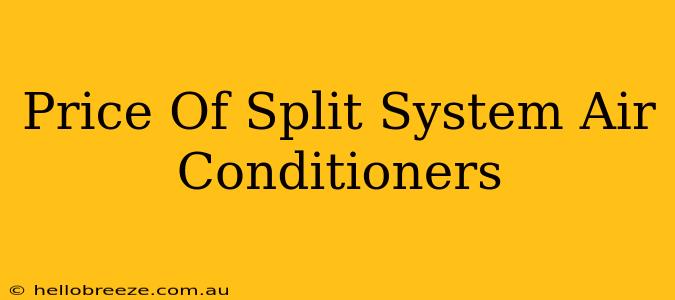Buying a new split system air conditioner can be a significant investment, so understanding the price range is crucial. This guide breaks down the factors influencing the cost of split system air conditioners, helping you make an informed decision.
Factors Affecting the Price of Split System Air Conditioners
Several factors contribute to the wide price range of split system air conditioners. Understanding these will help you budget effectively and choose a system that fits your needs and budget.
1. Cooling Capacity (BTU/h):
The higher the BTU/h rating, the larger the area the unit can cool. Larger capacities naturally command higher prices. A small unit for a single room will be far cheaper than a large unit for an entire house. Consider the square footage you need to cool accurately to avoid overspending or underpowering your system.
2. SEER Rating (Seasonal Energy Efficiency Ratio):
The SEER rating measures the unit's energy efficiency. Higher SEER ratings indicate greater energy efficiency and lower running costs, but they typically come with a higher upfront purchase price. Investing in a higher SEER-rated unit might seem more expensive initially, but the long-term savings on energy bills can offset the difference.
3. Features and Technology:
Many modern split systems offer advanced features like:
- Inverter technology: Provides more precise temperature control, quieter operation, and improved energy efficiency. This feature usually increases the price.
- Smart home integration: Allows control through a smartphone app, enabling remote operation and scheduling. Adds to the cost.
- Wi-Fi connectivity: Similar to smart home integration, offering remote control capabilities. This convenience often comes at a premium.
- Air purification: Some units include filters to remove allergens and pollutants, enhancing air quality. This added functionality increases the price.
Choosing a model with advanced features will undoubtedly increase the overall price.
4. Brand and Model:
Reputable brands often have higher prices due to their quality, reliability, and warranties. Research different brands and compare features and prices before making a decision. Don't automatically assume the most expensive is the best; compare specifications carefully.
5. Installation Costs:
Don't forget the installation costs! This can vary significantly depending on factors like the complexity of the installation, the distance between the indoor and outdoor units, and the installer's rates. Obtain multiple quotes from reputable installers to compare prices and ensure you're getting a fair deal.
Price Ranges: A General Overview
While prices vary widely, here's a general idea of what to expect:
- Budget-friendly options: Smaller units with basic features may start around $500-$1000.
- Mid-range options: Units with better features and higher SEER ratings will typically cost between $1000-$3000.
- High-end options: Large capacity units with advanced features and high SEER ratings can cost $3000 and above.
Tips for Saving Money:
- Shop around: Compare prices from different retailers and installers.
- Consider rebates and incentives: Some governments offer rebates for energy-efficient appliances.
- Look for sales and promotions: Retailers often have sales throughout the year.
- Prioritize your needs: Focus on features that are essential to you and avoid unnecessary extras.
Remember to factor in installation costs and ongoing energy expenses when evaluating the overall cost of a split system air conditioner. Careful planning and research will help you find a system that meets your cooling needs without breaking the bank.

